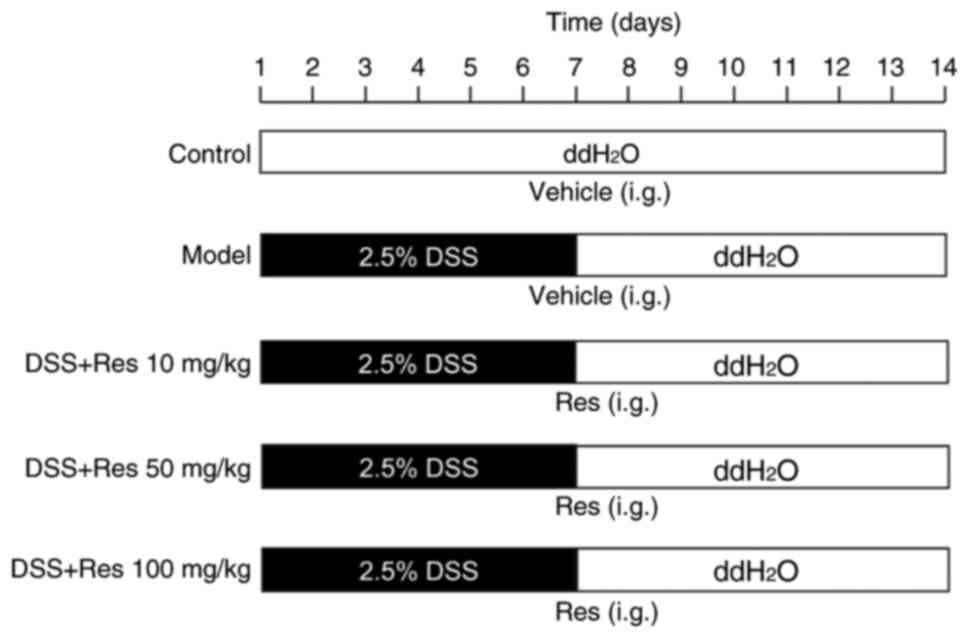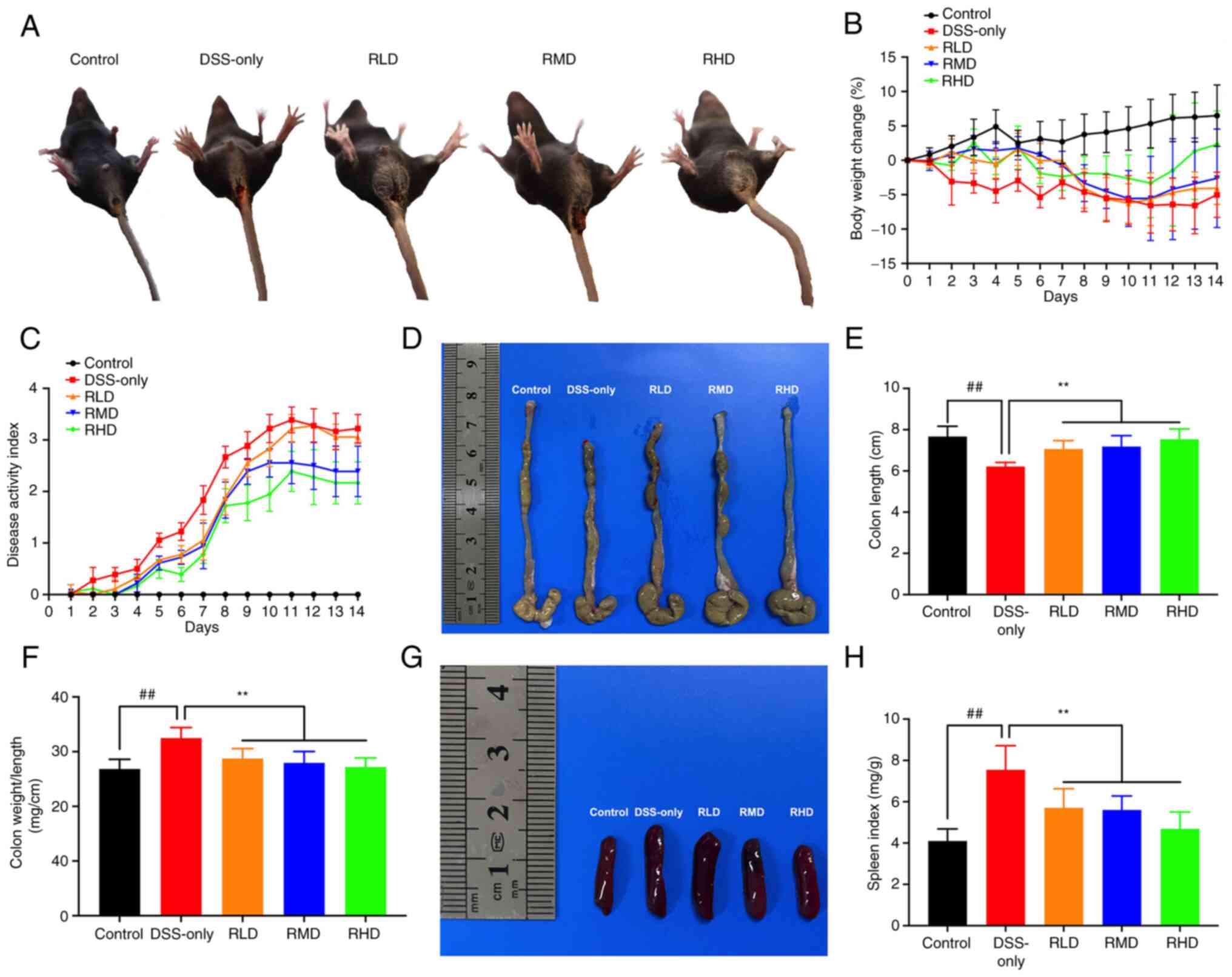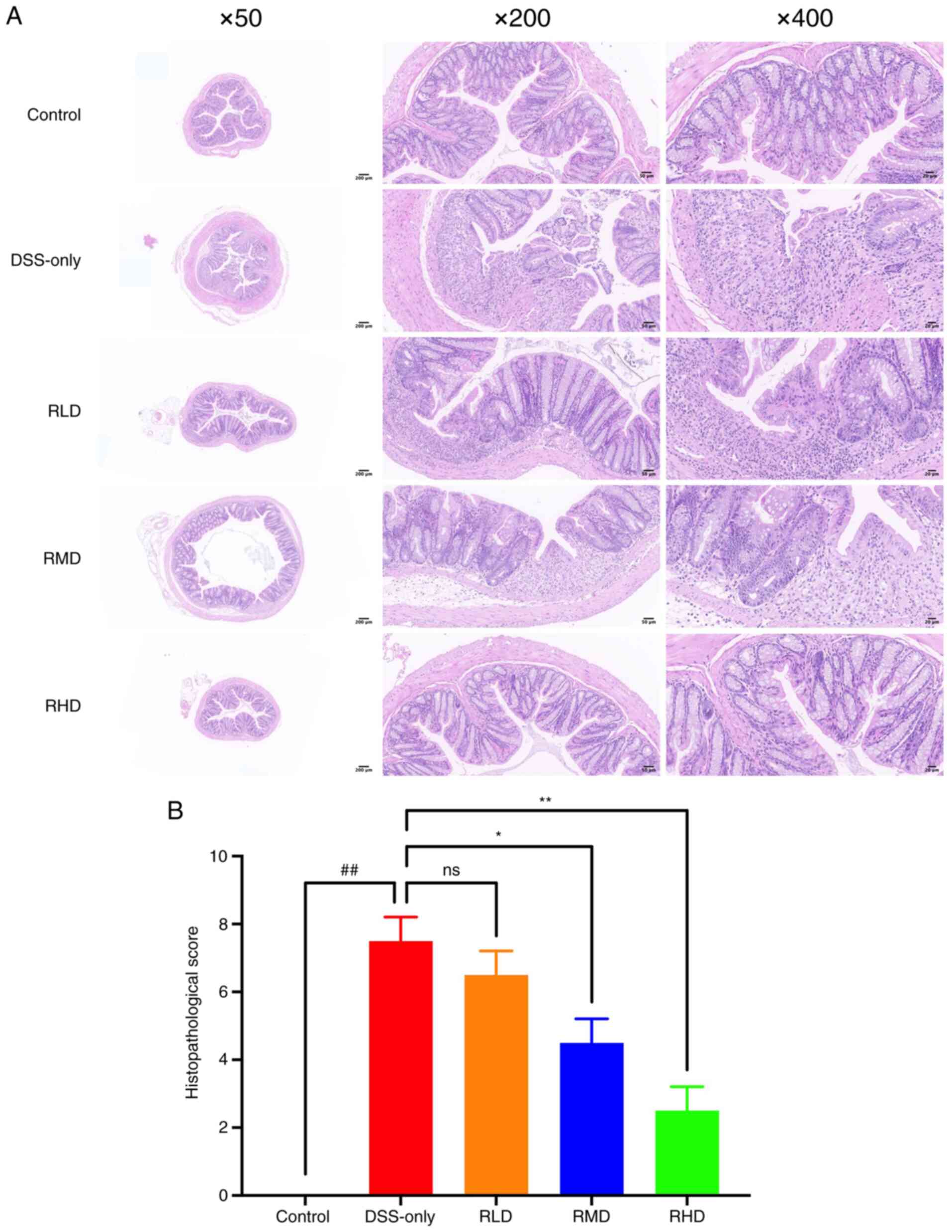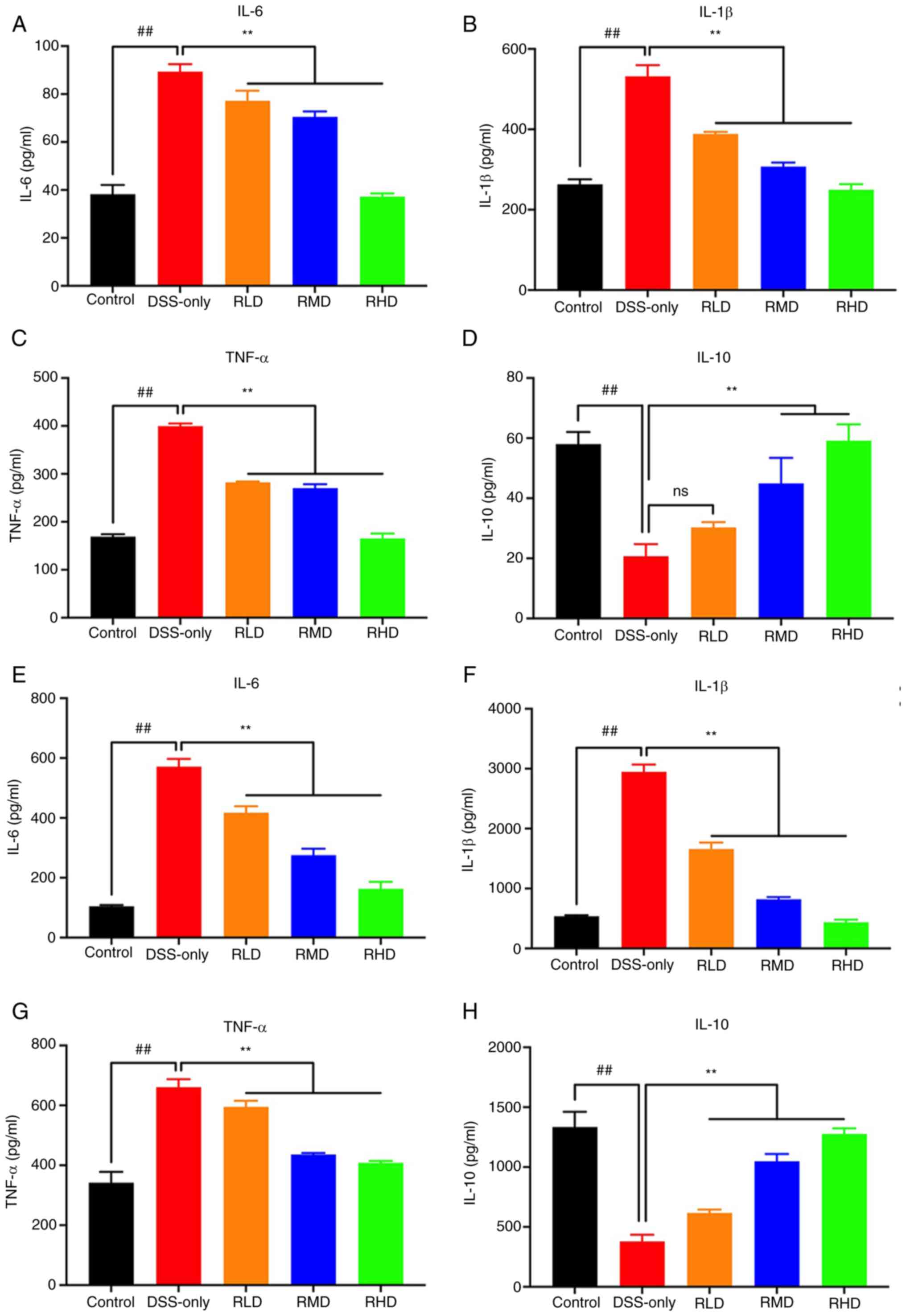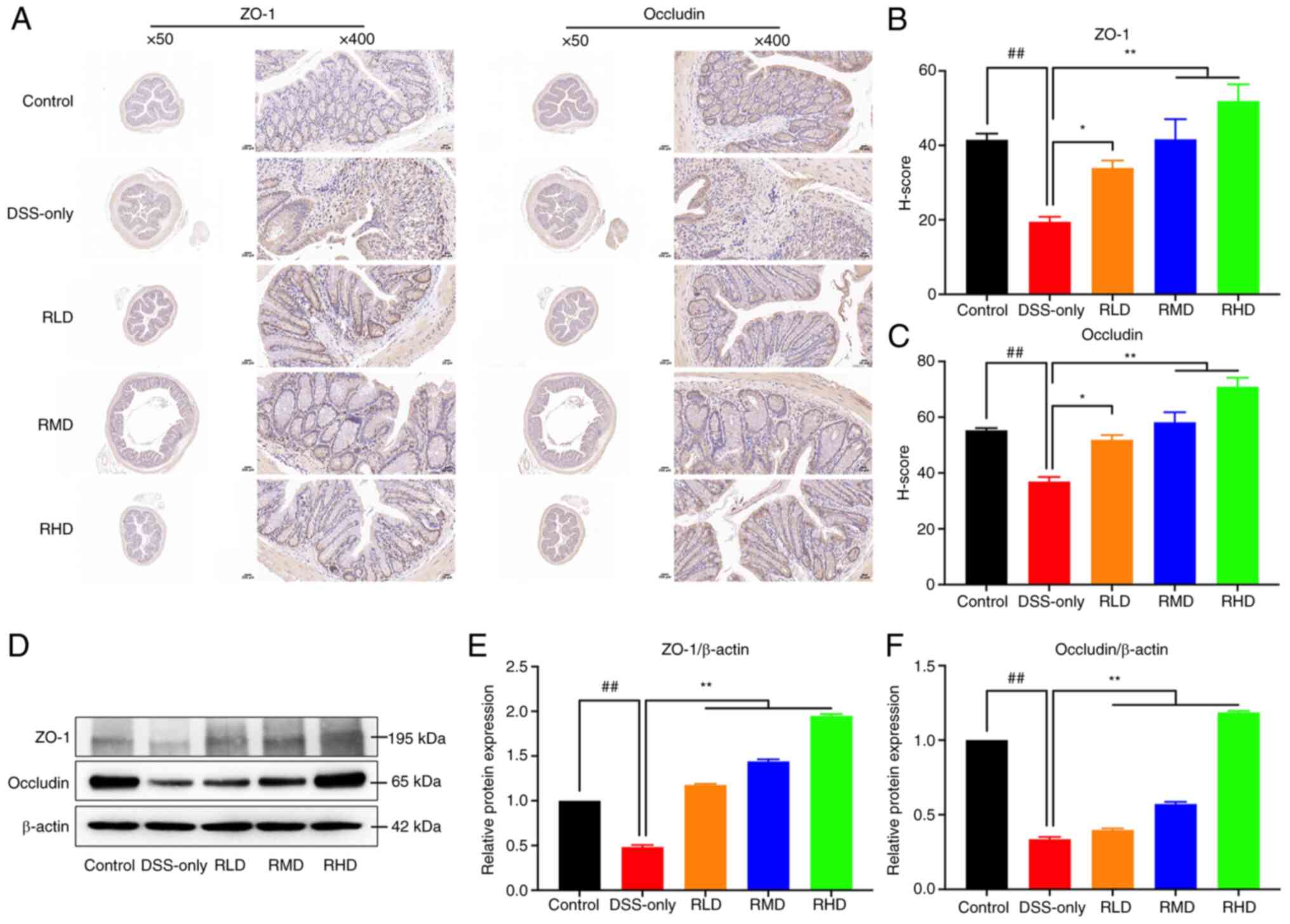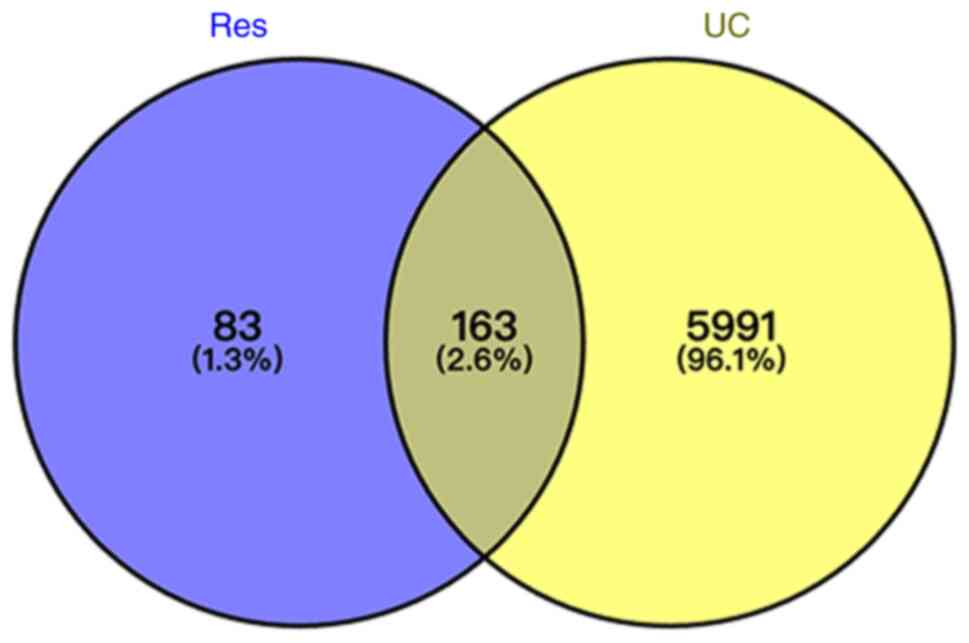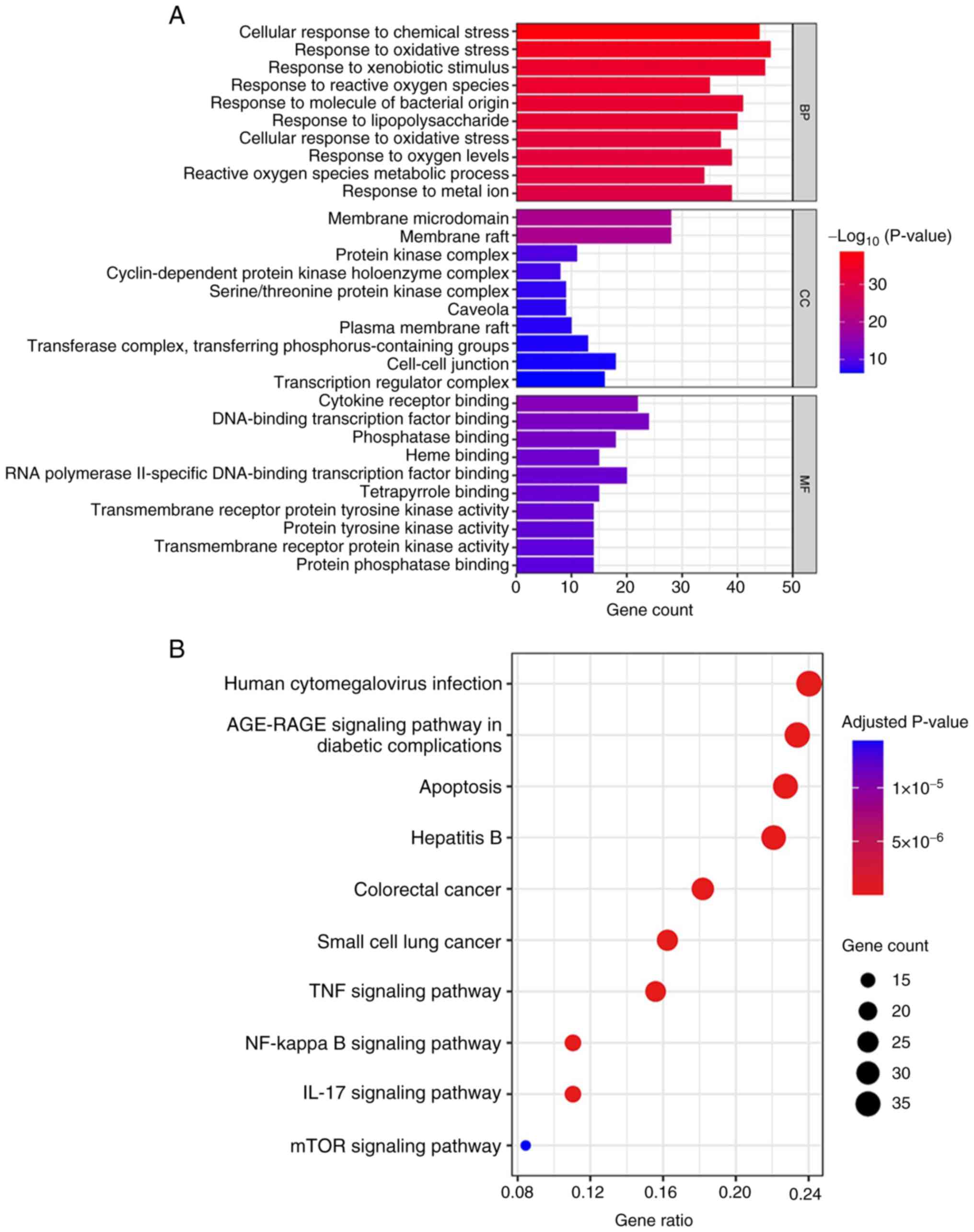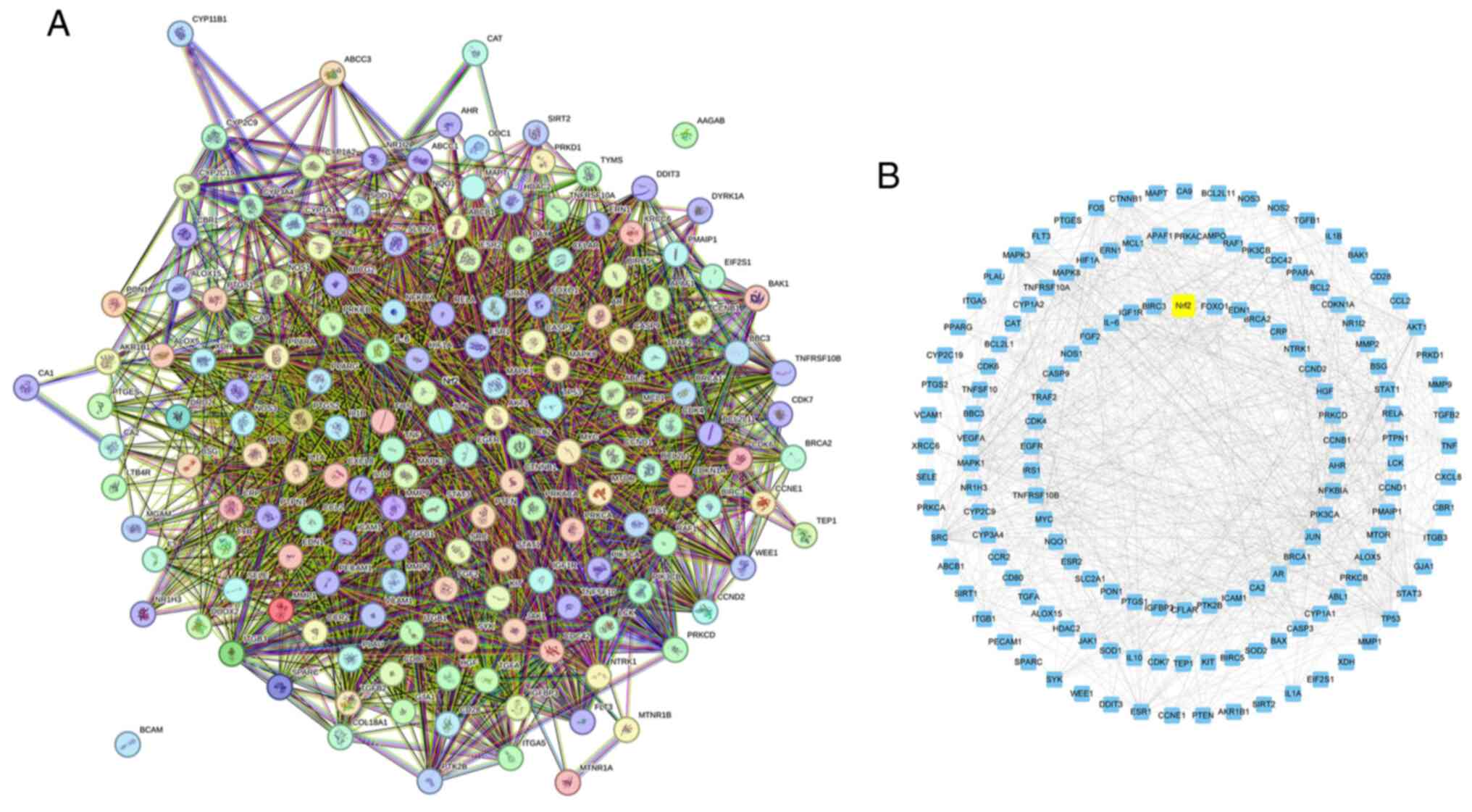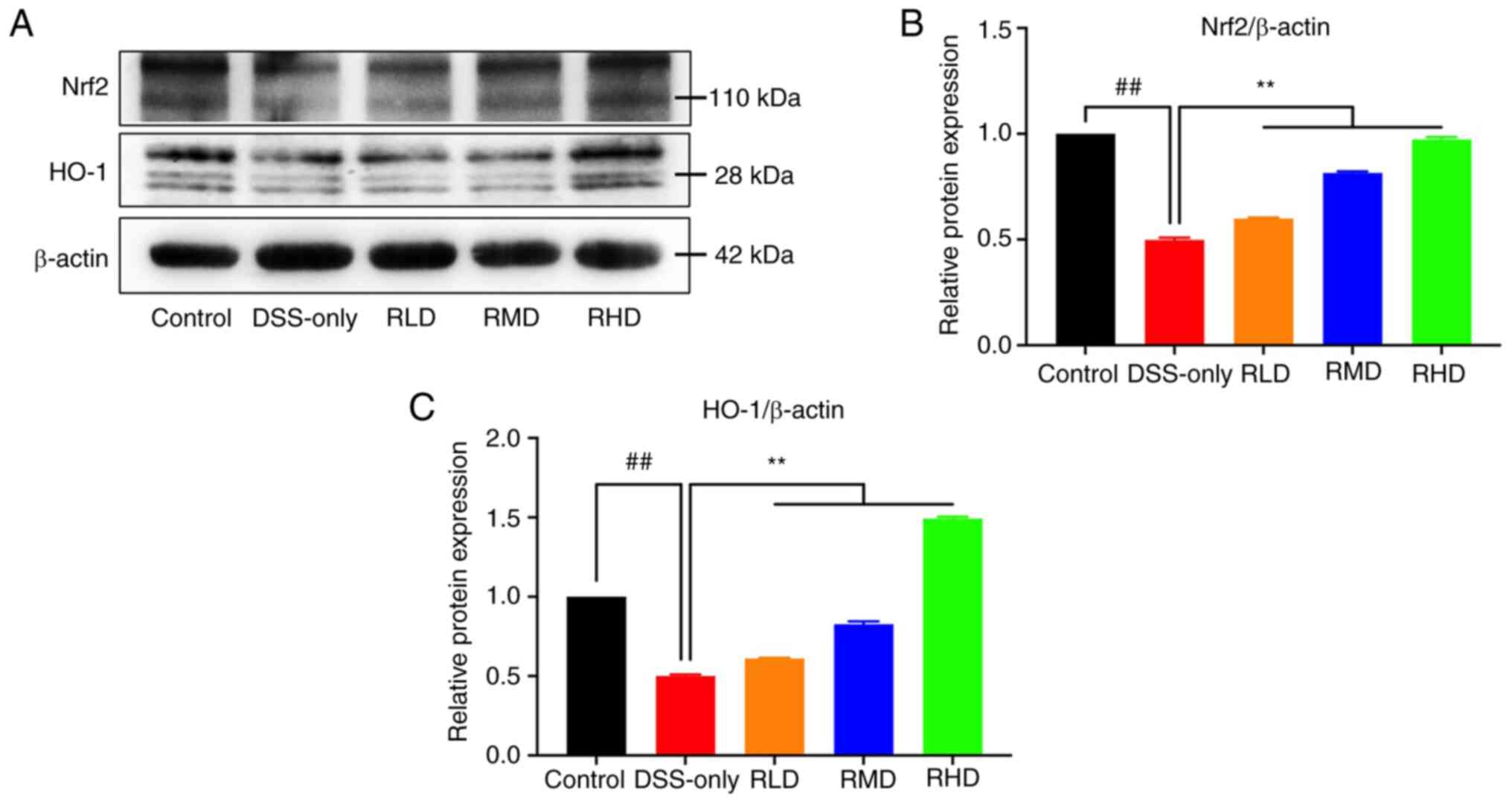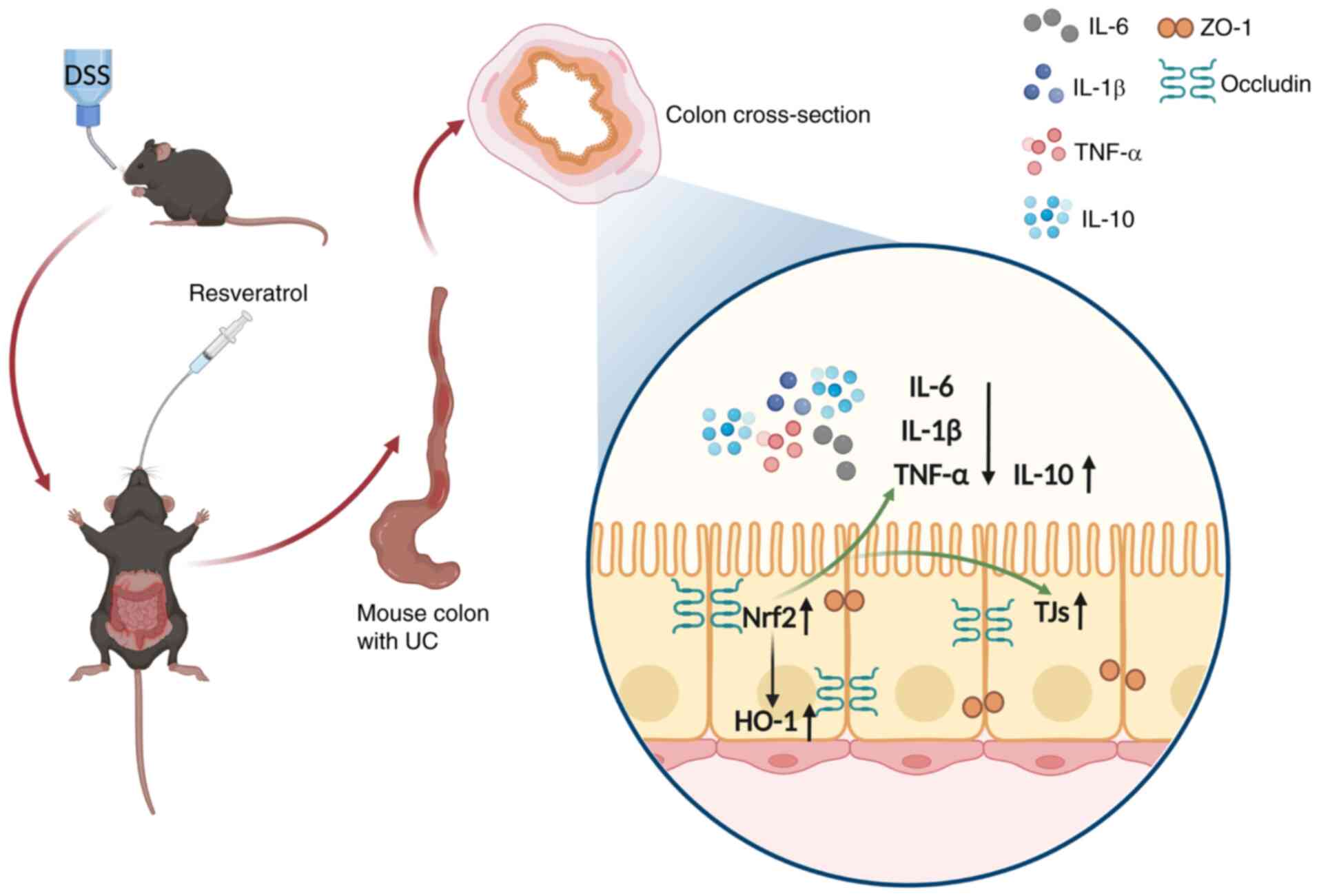Resveratrol ameliorates ulcerative colitis by upregulating Nrf2/HO‑1 pathway activity: Integrating animal experiments and network pharmacology
- Authors:
- Published online on: March 14, 2024 https://doi.org/10.3892/mmr.2024.13201
- Article Number: 77
-
Copyright: © Yu et al. This is an open access article distributed under the terms of Creative Commons Attribution License.
Abstract
Introduction
Inflammatory bowel disease (IBD) encompasses a group of chronic, recurrent and idiopathic inflammatory disorders affecting the gastrointestinal tract, including Crohn's disease and ulcerative colitis (UC). UC is considered a precancerous condition for colorectal cancer but its causes and development remain unclear (1). The primary symptoms include abdominal pain, diarrhea and hematochezia. Due to the combined effects of susceptibility genes and environmental factors, the intestinal mucosa initiates a prolonged and intense immune response to various stimuli, leading to emergence and progression of inflammation (2). A previous epidemiological survey reported that UC affects ~10 million people globally, coinciding with changes in dietary habits and circadian rhythms (3). Current pharmacological treatments such as 5-aminosalicylic acid, corticosteroids and immunosuppressants, have limited effectiveness. Long-term use can lead to side effects, including diarrhea, nausea, abdominal pain, pancreatitis and renal function damage, imposing psychological and economic burdens on patients. Additionally, patient non-responsiveness to systemic steroids remains a challenge in IBD management (4–6). Therefore, understanding the pathogenesis of UC and developing novel intervention and treatment strategies is key.
Previous studies have highlighted the key role of intestinal mucosal barrier integrity in the pathophysiology of various diseases (7,8). The intestinal mucosal barrier, separating the external and internal environments, is the largest and most important defense against the external environment. Maintaining an intact intestinal barrier is key for protecting against microorganisms and toxins, serving as the primary defense in the gastrointestinal tract against external pathogens. The functional integrity of this barrier is primarily determined by the epithelium and tight junctions (TJs) that seal the paracellular space. Key TJ proteins, including intracellular protein zonula occludens-1 (ZO-1) and transmembrane proteins occludin and claudins, are essential for maintaining the integrity of the intestinal mucosal barrier. Numerous studies suggest that dysfunction of the intestinal mucosal barrier contributes to worsening of IBD, particularly in patients with UC (9,10). Therapeutic strategies that strengthen the intestinal mucosal barrier may provide new pathways for treating UC.
In recent years, phyto-polyphenolic extracts have been used in treating and preventing various types of diseases due to their comprehensive anti-inflammatory and antioxidant properties (11,12). Resveratrol (Res), a non-flavonoid polyphenolic compound primarily found in grape leaves and skins, is a key bioactive component in wine and grape juice. In vivo and in vitro studies have shown that Res has antioxidative, anti-inflammatory, anti-neoplastic and cardioprotective effects, along with benefits such as cost-effectiveness, minimal side effects, easy oral absorption and renal and fecal excretion following metabolism (13,14). Empirical studies suggest that dietary Res supplementation improves clinical outcomes and life quality in patients with UC, partly by decreasing inflammation and oxidative stress (15,16). However, the mechanism behind these effects is not fully understood.
An array of natural phyto-polyphenols improves oxidative stress levels by enhancing the nuclear factor erythroid-2-related factor 2 (Nrf2) pathway (17). Nrf2 is a key target in recent oxidative stress defense mechanism research (18). Nrf2 controls the expression of detoxifying enzymes and antioxidant proteins, such as: NAD(P)H, quinone oxidoreductase 1 (NQO1), glutamate cysteine ligase catalytic subunit and heme oxygenase 1 (HO-1), via antioxidant response elements thereby combating oxidative stress (19,20). HO-1, an effector protein downstream of Nrf2, breaks heme into ferrous ion (Fe2+), carbon monoxide (CO) and biliverdin. The metabolism of the heme group is beneficial to preventing oxidation. As a necessary endogenous gas messenger molecule, CO has anti-tinflammatory, vasodilator and microcirculation metabolic roles. Biliverdin and the product of its metabolism, bilirubin, not only have powerful antioxidant and anti-inflammatory effects but also effectively scavenge reactive oxygen species activity to defend against peroxide, peroxynitrite, hydroxyl and superoxide free radicals (21). Previous in vitro study has showed that Res increases Nrf2 and HO-1 expression, reducing dextran sulfate sodium (DSS)-induced intestinal epithelial cell (IEC) cytotoxicity, inflammation, barrier dysfunction and TJ protein loss (22). Therefore, Res might also protect the intestinal mucosal barrier by modulating the Nrf2/HO-1 signaling pathway in vivo.
The present study aimed to assess the modulation of the Nrf2/HO-1 signaling pathway by Res and whether this can alleviate DSS-induced experimental UC in mice, offering a novel perspective for Res treatment and prevention of UC and intestinal mucosal barrier-associated pathology.
Materials and methods
Chemicals and reagents
DSS (molecular weight, 36,000-50,000 Da) was purchased from Shanghai Yeasen Biotechnology Co., Ltd. Res (purity ≥98%) was purchased from Shanghai Aladdin Biochemical Technology Co., Ltd. ELISA kits included IL-6 (cat. No. CHE0006-048, Beijing 4A Biotech Co., Ltd.), IL-1β (CHE0015-048, Beijing 4A Biotech Co., Ltd.), TNF-α (CHE0004-048, Beijing 4A Biotech Co., Ltd.) and IL-10 (CHE0016-048, Beijing 4A Biotech Co., Ltd.). RIPA buffer, protease and phosphatase inhibitors, and enhanced BCA Protein Assay kit were purchased from Beyotime Institute of Biotechnology. Antibodies used included rabbit anti-ZO-1 (cat. no. GB111402; Wuhan Servicebio Technology Co., Ltd.), anti-occludin (cat. no. 91131; Cell Signaling Technology, Inc.), anti-Nrf2 (cat. no. 16396-1-AP; Proteintech Group, Inc.), anti-HO-1 (cat. no. 82551; Cell Signaling Technology, Inc.) and anti-β-actin (cat. no. 380624; Chengdu Zen-Bioscience Co., Ltd.) and HRP-conjugated goat anti-rabbit IgG (cat. no. 7074; Cell Signaling Technology, Inc.).
Animals and experimental protocol
A total of 30 male C57BL/6J mice (age, 8 weeks; weight, 20–22 g), were purchased from SPF (Beijing) Biotechnology Co., Ltd. Mice were housed in individual ventilated cages with controlled temperature (23±1°C) and humidity-controlled (45–55%) (12 h light/dark cycle) and standard laboratory chow and water ad libitum. They were allowed to acclimatize for ≥1 week. All animal care and experimental procedures were in accordance with the guidelines of the Animal Welfare Ethics Committee of Dali University (Dali, China; approval no. 2023-PZ-194).
According to previous studies, the safe dose of Res for relieving UC in mice is 10–100 mg/kg (23–25). To reflect the concentration-effect relationship according to Singh et al (26), Res was used low (10 mg/kg), medium (50 mg/kg) and high (100 mg/kg) doses. The mice were divided randomly into five groups (n=6/group) as follows: Control; model (DSS-only); Res low dose (RLD); Res medium dose (RMD) and Res high dose (RHD).
To induce the experimental UC model, mice received 2.5% DSS in filtered drinking ddH2O for 7 days. On day 8, the DSS solution was replaced with filtered ddH2O. The control group received only filtered ddH2O for 14 days. Res was dissolved in 0.5% carboxymethyl cellulose sodium (CMC-Na). Res (10, 50 or 100 mg/kg) or vehicle (0.5% CMC-Na) was administered intragastrically for 14 days, starting concurrently with DSS exposure (Fig. 1).
The general condition and body weight change of mice were monitored and recorded daily. The study employed humane endpoints according to AVMA Guidelines for the Euthanasia of Animals (27), including when the mice showed an inability to obtain food or water on their own, had a weight loss of >20% of their starting body weight, difficulty moving, were depressed in the absence of anesthesia, or their body temperature was persistently below 37°C. All animal experiments were performed in accordance with the regulations of the ARRIVE guidelines (28). No mice died or were euthanized before the end of the experiment. On day 15, mice were anesthetized with 1% sodium pentobarbital (60 mg/kg, intraperitoneal). A single collection of orbital venous blood (300 µl/mouse) was performed with an aseptic capillary glass tube. After centrifugation at 1,500 × g for 10 min at 4°C, the serum was collected. Spleen was collected and weighed, and the spleen index was calculated as the ratio of spleen weight to body weight. The entire colon from cecum to anus were then collected, weighed, and length measured. A portion of colon tissue was fixed in 4% paraformaldehyde at 4°C for 6 h for histopathological examination and immunohistochemistry; remaining tissue and serum were stored at −80°C for further analysis.
Disease activity index (DAI) score
DAI score was calculated based on a previous study (29). Briefly, DAI score is the average of body weight change, diarrhea condition and bloody stool test scores (Table I).
Histopathological examination
The fixed colon samples were dehydrated with graded ethanol solution, tissues were embedded in paraffin wax. A serial frontal section was cut at intervals for 5 µm and stained with hematoxylin and eosin (H&E) staining for at room temperature (hematoxylin staining for 3 min and eosin staining for 15 sec) for histopathology. The pathological changes in the colon mucosa were observed under a light microscope. Histological damage was graded following Dieleman's criteria (30) (Table II).
Immunohistochemistry
Immunohistochemistry was conducted to assess ZO-1 and occludin protein expression in colon tissue. Briefly, slides were de-paraffinized at room temperature, washed with xylene and rehydrated in descending ethanol series. The colon sections were subjected to antigen retrieval with 0.01 M sodium citrate buffer and their endogenous peroxidase activity was blocked at room temperature for 30 min in 1% hydrogen peroxide/phosphate-buffered saline solution. Tissues were blocked for 1 h at room temperature with 5% goat serum (Wuhan Servicebio Technology Co., Ltd.). Slides were incubated overnight at 4°C with primary antibodies against ZO-1 (1:500) and occludin (1:300) and incubated for 1 h at room temperature with HRP-conjugated goat anti-rabbit IgG secondary antibody (1:3,000). Staining was performed with 3,3-diaminobenzidine for 5 min at room temperature and counterstained with hematoxylin for 3 min at room temperature. Images were captured under a light microscope at ×50 and ×400 magnification. Staining results were quantified using the following equation: H-Score=(percentage of weak intensity ×1) + (percentage of moderate intensity ×2) + (percentage of strong intensity ×3) (31–34).
ELISA
The serum concentrations of IL-6, IL-1β, TNF-α and IL-10 were measured using ELISA kits according to the manufacturer's instructions. Absorbance for each well was recorded at a wavelength of 450 nm using a microplate reader.
Western blotting
Protein levels of ZO-1, occludin, Nrf2 and HO-1 in colon tissue were determined using western blotting. A total of ~20 mg tissue was homogenized in 200 µl ice-cold RIPA buffer supplemented with 1% protease and phosphatase inhibitors for 30 min before centrifugation at 15,616 × g for 10 min at 4°C to obtain supernatant. The loading buffer was mixed in a 1:4 ratio, and the mixture was boiled at 100°C for 10 min to denature the protein. Protein concentration was determined using an enhanced BCA Protein Assay kit. 20 µg protein/lane was separated by SDS-PAGE on a 10% gel and electro-transferred onto a PVDF membrane (Merck KGaA), then blocked with 5% non-fat milk for 2 h at room temperature and incubated overnight at 4°C with primary antibodies against ZO-1 (1:1,000), occludin (1:1,000), Nrf2 (1:6,000), HO-1 (1:1,000) and β-actin (1:10,000). The blots were incubated with HRP-conjugated goat anti-rabbit IgG secondary antibody (1:5,000) for 1 h at room temperature. β-actin was used as a loading control. The signal was detected using BeyoECL Moon kit (Beyotime Institute of Biotechnology) and a ImageQuant LAS 4000 mini chemiluminescence imaging system (Cytiva) and protein expression was quantified with Image J v1.51 (National Institutes of Health).
Assessment of pharmacokinetic (PK) parameters
PK study examine the absorption, distribution, metabolism and excretion (ADME) processes of drugs, including oral bioavailability (OB), Caco-2 permeability, blood-brain barrier (BBB) permeability and drug-likeness (DL) (35). PK parameters of Res were sourced from Traditional Chinese Medicine systems pharmacology database and analysis platform (TCMSP; tcmsp-e.com/) database, a phytochemical database for TCM active ingredients.
Potential targets of Res and UC
The potential targets of Res were obtained from TCMSP, DrugBank (go.drugbank.com/) and PubChem (pubchem.ncbi.nlm.nih.gov/) databases. Genes associated with UC were identified through the GeneCards (genecards.org/), MalaCards (malacards.org/) and NCBI-gene (ncbi.nlm.nih.gov/) databases. After removing duplicate target genes, the online tool Venny2.1 (36) (bioinfogp.cnb.csic.es/tools/venny) was used to identify overlaps between Res targets and UC targets.
Functional enrichment analysis
Database for Annotation, Visualization and Integrated Discovery (37) (7eg7d.ncifcrf.gov/) and Kyoto Encyclopedia of Genes and Genomes (KEGG) pathway (38) (genome.jp/7eg/) databases were used for Gene Ontology (GO) function enrichment and KEGG pathway analyses. The analyzed data were visualized using the R Project 4.2.3 (Shorstop Beagle).
Protein-protein interaction (PPI) network analysis
Potential compound-disease target genes were uploaded to Search Tool for the Retrieval of Interaction Gene (STRING) (cn.string-db.org/) to construct the PPI network. Parameters set included ‘Homo sapiens’ as the organism and ‘medium confidence (0.400)’. The Cytoscape 3.7.0 (Cytoscape 3.7.0 Release Notes) was used to visualize the interaction network.
Molecular docking
Target protein crystal structures were sourced from Protein Data Bank (rcsb.org/) database and preprocessed, including hydrogenation, amino acid modification, energy optimization and force field parameter adjustment, as previously described (39). Next, two-dimensional structure of the active compound was downloaded from the PubChem database. After optimizing for minimum free energy and obtaining a low energy conformation, the protein structure was docked with the ligand structure (39). AutoDock Vina 1.2.2 (vina.scripps.edu/) was used for hydrogenation and charge balancing and PyRx 0.8 (pyrx.sourceforge.io/) was used for docking. PyMOL 2.3 (pymol.org/2/) was used for visualization before analysis using Discovery Studio 4.5 (Dassault systemes).
Statistical analysis
All data are presented as the mean ± SD of three independent experiments. The measurement data obeying normal distribution between two groups were analyzed by unpaired t test and one-way analysis of variance was used for comparison among multiple comparisons followed by Tukey's post hoc test. All statistical analyses were performed using GraphPad Prism 9.0 (Dotmatics). P<0.05 was considered to indicate a statistically significant difference.
Results
Res attenuates DSS-induced UC in mice
To determine the effect of Res in experimental UC, physiological parameters of mice were monitored and assessed, including body weight, diarrhea and hematochezia, daily during DSS intervention. No pathological manifestations were observed in the control group (Fig. 2). However, the DSS-only group exhibited a marked reduction in body weight starting from the 2nd day post −2.5% DSS administration (Fig. 2B). From day 5, mice in the DSS-only group showed symptoms such as loose stool, fecal occult blood, decreased food intake, unkempt fur and decreased responsiveness to external stimuli; concurrently, DAI score increased compared with the control group. These symptoms were moderately decreased in mice treated with Res compared with the DSS-only group. DAI score in Res treatment groups were reduced compared with the DSS-only group (Fig. 2C).
Furthermore, in the DSS-only group there was significant shortening of the colon, significant increase in colonic weight-to-length ratio and spleen index and notable spleen enlargement compared with the control. These changes in the colon and spleen were significantly decreased in all Res treatment groups compared with the DSS-only group, suggesting that Res alleviated clinical manifestations of experimental UC in mice (Fig. 2D-H).
Res alleviates intestinal mucosal histopathological injury in DSS-induced UC mice
Histopathological examination was conducted to evaluate colonic injury. The DSS-only group showed extensive mucosal erosion, crypt depletion, destruction of mucosal epithelium and intestinal glandular architecture, connective tissue proliferation and infiltration of granulocytes and lymphocytes (Fig. 3A).
The degree of colonic injury and intestinal inflammation in the Res-treated groups was less severe compared with the UC group (Fig. 3A). The histological score also showed that the pathological changes of colonic mucosa in Res group were alleviated (Table II). The histological scores for the RMD and RHD groups were significantly lower compared with DSS-only group, although there was no significant difference between RLD and DSS-only group (Fig. 3B). These results indicated that middle and high dosages of Res effectively decreased intestinal mucosal damage induced by DSS in experimental UC.
Res decreases secretion of inflammatory cytokines in DSS-induced UC mice
The production of pro-inflammatory cytokines in serum and colonic tissue was quantified using ELISA. The levels of IL-6, IL-1β, and TNF-α were significantly increased in DSS-only group compared with the control in both serum and colonic tissue. In the RLD, RMD and RHD groups, levels of these cytokines were significantly decreased compared with DSS-only group (Fig. 4A-C, E-G).
The levels of IL-10 were significantly decreased in DSS-only group compared with the control, and restored by Res, but no significant different in the serum RLD group. (Fig. 4D, H). These findings suggested that Res decreased inflammation induced by DSS in experimental UC mice.
Res enhances TJ protein expression in DSS-induced UC mice
ZO-1 and occludin, key TJ proteins, serve a key role in maintaining intestinal mucosal barrier integrity (40). In the present study, colonic tissue of mice was subjected to immunohistochemical staining and western blotting. DSS significantly decreased protein expression of ZO-1 and occludin in colonic tissues of experimental UC mice compared with the control. The results of H-score quantitative immunohistochemical staining showed that ZO-1 and occludin H-score decreased significantly following DSS induction. Compared with DSS-only group, the protein expression and H-score of ZO-1 and occludin in RLD, RMD and RHD groups were significantly upregulated, particularly at a dosage of 100 mg/kg (Fig. 5). Collectively, these results suggested that Res treatment enhanced integrity of the intestinal mucosa.
PK parameters of Res
The Res profile across 12 principal drug characterization and evaluation parameters is presented in Table III. OB, the fraction of orally administered dose that reaches systemic circulation, reflects the integration of the ADME process. DL is used to evaluate the ‘drug-like’ qualities of potential compounds (41). Res had an OB of 19.07% and a DL of 0.11. Res also had a low molecular weight and was classified as moderately permeable (−0.3< BBB <0.3).
Potential targets of Res and UC
Using TCMSP, DrugBank and PubChem databases, a total of 246 unique targets were obtained after removing duplicates. UC-associated target genes were sourced from GeneCards, MalaCards and NCBI-gene databases. A total of 6,154 unique targets were identified after duplicate removal. Venny2.1 was used to determine the intersection, identifying 163 overlapping genes between compound and disease targets (Fig. 6).
GO enrichment and KEGG pathway analysis
GO enrichment and KEGG pathway analyses were conducted on 163 identified target genes to understand the function and pharmacological mechanism of Res. According to GO analysis, the overlapping genes were involved in biological processes associated with ‘response to oxidative stress’, ‘response to xenobiotic stimulus’, ‘cellular response to chemical stress’, ‘response to molecule of bacterial origin’ and ‘response to lipopolysaccharide’. In terms of cellular components (CCs), the target genes were primarily associated with ‘membrane microdomain’ and ‘membrane raft’. The genes enriched in molecular functions (MFs) were associated with ‘DNA-binding transcription factor binding’, ‘cytokine receptor binding’, ‘RNA polymerase II-specific DNA-binding transcription factor binding’, ‘phosphatase binding’ and ‘heme binding’ (Fig. 7A). KEGG analysis revealed that ‘apoptosis’, ‘colorectal cancer’, ‘TNF signaling pathway’, ‘NF-kappa B signaling pathway’, and ‘IL-17 signaling pathway’ might be involved in regulating UC (Fig. 7B).
PPI network and key target screening
The common targets of Res and UC association were analyzed using the STRING program, selecting for medium confidence with a score >0.400 to construct the PPI network. Cytoscape was then used for visualization (Fig. 8). Nrf2 was identified as having a strong association with the potential molecular mechanism of Res alleviating UC, functioning as a regulator of anti-inflammatory and antioxidant capacity both in vivo and in vitro. Therefore, it was hypothesized that Res may protect the intestinal mucosal barrier and improve UC by modulating anti-inflammatory and antioxidant pathways associated with Nrf2.
Molecular docking
Based on the aforementioned analysis, it was hypothesized that Res could counteract UC by influencing the antioxidant pathway involving Nrf2. Dock Res to the hydrophobic pocket of Nrf2 to calculate affinity. Binding affinity (kcal/mol) indicates the stability between receptor and ligand; a lower affinity suggests greater stability (42). A binding energy <-5 kcal/mol is indicative of strong affinity (43). Res established π-σ interactions with Nrf2 Lys462 and π-R interactions with Nrf2 Leu450 and Ala463. The molecular docking results demonstrated that Res and Nrf2 had strong affinity (Fig. 9; Table IV).
Res attenuates DSS-induced experimental UC via Nrf2/HO-1 pathway
Protein expression of Nrf2 and its downstream target HO-1 was assessed by western blotting. Nrf2 and HO-1 expression in colon tissue was significantly reduced in the DSS-only group compared with the control, while Res treatment significantly increased Nrf2 and HO-1 levels (Fig. 10). These results suggested that Res exerted a protective effect on DSS-induced experimental UC via the Nrf2/HO-1 pathway.
Discussion
UC is a complex condition characterized by inflammation and ulceration of the rectum and colon mucosa, with severity that can increase over time (44). Determining risk of UC progression and identifying the most effective treatment strategy pose clinical challenges, particularly as a number of patients experience adverse reactions to treatment (45). Thus, identifying novel targets and intervention methods is crucial. The present study aimed to evaluate the mechanism by which Res decreases experimental UC in mice. Res improved intestinal mucosal barrier dysfunction caused by experimental UC model, with this protective effect predominantly mediated by activation of the Nrf2/HO-1 signaling pathway (Fig. 11).
In the present study, an experimental UC mouse model was established using DSS solution consumption, a method known to resemble human UC symptoms (46). Mice in the model group exhibited clinical symptoms such as weight loss, diarrhea and hematochezia. Pathological changes such as colon shortening, splenomegaly, intestinal mucosal hyperemia, edema, ulceration, crypt destruction and inflammatory infiltration confirmed that DSS induced acute intestinal injury in mice. The changes in colon and spleen suggested that intestinal mucosal inflammation led to interstitial fibrosis, which may have caused abnormal smooth muscle function, decreased mucosal motility and colon shortening. The spleen enlargement was likely due to hyperemia, edema and lymphocytosis, resulting in increased spleen index. Similar symptoms were observed in another study using a DSS-induced chronic UC model (47). To assess inflammation in experimental UC mice, pro-inflammatory and anti-inflammatory cytokine levels in serum and colon tissues were quantified.
Inflammation is key in maintaining the integrity of the intestinal mucosal barrier (48). IL-6 and IL-1β levels in serum from patients with IBD positively correlate with inflammation severity (49,50). TNF-α, a key initiator of intestinal mucosal barrier injury, activates NF-κB, triggering production of various inflammatory cytokines and exacerbating barrier impairment (51). Cui et al (52) reported that Res alleviates the inflammatory stress state of UC mice by regulating CD3+ T cells that express TNF-α and decreasing the percentage of neutrophils in mesenteric lymph nodes and lamina propria. This decreases the incidence of colon cancer associated with colitis. By contrast, IL-10, an anti-inflammatory cytokine, decreases inflammation and protects the intestinal barrier by improving TJ permeability (53).
In the present study, DSS increased IL-6, IL-1β and TNF-α levels and reduced IL-10 protein expression in serum and colon tissue of experimental UC mice. However, Res administration (50 and 100 mg/kg) effectively decreased the secretion of pro-inflammatory cytokines (IL-6, IL-1β and TNF-α) and promoted the secretion of anti-inflammatory cytokine (IL-10), thus alleviating DSS-induced inflammation, suggesting a direct link between level of inflammation and the integrity of the intestinal mucosal barrier.
In previous studies, the role of the intestinal barrier in the pathogenesis and progression of UC has received considerable attention. The intestinal barrier comprises IECs and TJs between these cells. TJ proteins, including the cytoplasmic protein ZO family and transmembrane proteins occludin and claudins, are crucial components of the intestinal mucosal barrier, protecting against invasion of bacteria, pathogens, endotoxins and other harmful substances (54,55). The present study confirmed that DSS compromised integrity of the intestinal mucosal barrier. However, 10, 50 and 100 mg/kg Res increased the protein expression of ZO-1 and occludin, reduced the histopathological score of colon tissues and improved DSS-induced intestinal injury in mice. Pan et al (47) reported similar findings, where Res significantly counteracted decreased levels of TJ proteins and increased the expression of inflammatory mediators, suggesting that Res exerts an anti-inflammatory effect by preserving integrity of the intestinal mucosal barrier. This conclusion is consistent with research using diquat-induced piglets, indicating the protective role of Res in another animal model (56).
To validate the hypothesis that Res may protect experimental UC mice by modulating the Nrf2/HO-1 pathway, network pharmacological analysis was conducted. PK merits priority in drug research, which describes the ADME process of drugs in vivo and the variation of drug concentration with time (57). A total of 12 PK characteristics of Res were obtained from TCMSP database. Among these, OB is a key parameter in evaluating drug distribution to systemic circulation. OB ≥30% is considered ‘drug-like’. Although the OB of Res is only 19.07%, there is growing evidence of the therapeutic potential of Res for intestinal health (58). But the relatively low OB and rapid metabolism of Res may limit its use in humans (59). However, other properties of Res exhibit primary drug features. Lipinski's rule of five, which includes criteria such as molecular weight <500 Da, Hdon <5, Hacc <10, AlogP <5 and RBN <10, indicates suitability for oral administration in small molecular compounds (60,61). Hdon and Hacc represent the number of hydrogen-bonded donors and receptors respectively, indicating the hydrogen bonding ability of the molecules. AlogP represents logarithmic value of lipid-water partition coefficient, which is necessary for measuring the hydrophobicity of molecules. RBN is the number of keys that allow themselves to rotate freely and is used to descrive molecular flexibility. Res met these criteria, highlighting its potential for drug development.
A total of 163 overlapping genes were identified by aligning potential targets of Res with UC-associated genes. To assess the interactions among overlapping genes, GO enrichment and KEGG pathway analyses were performed. GO enrichment showed that target genes were primarily associated with cellular responses to chemical and oxidative stress. The most prominent MF ontologies included ‘cytokine receptor binding’ and ‘DNA-binding transcription factor binding’. In terms of CC, a significant proportion of genes were related to cell membrane raft and microdomain. Specifically, in vivo studies have illustrated that Res decreases expression of inflammatory cytokines via inducible nitric oxide synthase (iNOS)/NF-κB and SIRT1/NF-κB signaling pathways, respectively, thereby mitigating UC and colitis-associated tumors (23,26).
The present KEGG pathway analysis highlighted that the TNF and NF-κB signaling pathways may be key pathways in UC. Differential expression genes were evaluated using a PPI network. The proteins with high association in the inner circle could be categorized into five groups based on primary function: Regulation of cell cycle and death, including forkhead box o1 (FOXO1), cyclin D2 (CCND2), caspase 8 and fas-associating protein with a novel death domain like apoptosis regulator and caspase 9 (CASP9); hormonal regulation, including insulin-like growth factor binding-protein-3 (IGFBP3), prostaglandin-endoperoxide synthase 1 (PTGS1), estrogen receptor beta (ESR2) insulin receptor substrate 1 (IRS1); cancer susceptibility genes, including, BRCA2) and myelocytoma oncogene; inflammatory response regulation, including C-reative protein (CRP), nuclear factor kappa-B subunit 1 alpha, phosphatidylinositol-4,5-bisphosphate 3-kinase catalytic subunit α (PIK3CA) and IL-6 and oxidative stress regulation, including NQO1 and NOS1. According to the results of network pharmacology, Res was suggested to target UC via anti-inflammatory and antioxidant pathways. However, among potential targets, except for Nrf2, other proteins were either not highly associated or cannot regulate anti-inflammatory and antioxidant processes at the same time.
Molecular docking showed that Nrf2 had a high affinity for Res. Western blotting further suggested that Res decreased DSS-induced inflammation and intestinal mucosal barrier injury by upregulating expression of Nrf2/HO-1 pathway proteins. According to Zheng et al (62), Nrf2 is necessary for Res mediated antioxidant effects in UC and Nrf2−/− mice are more likely to exhibit DSS-induced colitis and subsequent colon cancer. The aforementioned study provides support for the results of the present study and further corroborates that Res positively impacts UC via anti-inflammatory and antioxidant activity.
In summary, intragastric administration of Res decreased intestinal mucosal barrier injury in DSS-induced experimental UC mice. This improvement was evidenced by enhanced colon tissue morphology, decreased inflammation and increased expression of TJ proteins and antioxidant capacity in colon tissues. Through network pharmacology and empirical studies, it was determined that the beneficial effects of Res on UC were at least partially associated with the Nrf2/HO-1 pathway. This proposed mechanism provides a foundation for future research on Res as a potential anti-inflammatory and antioxidant therapeutic agent.
Acknowledgements
Not applicable.
Funding
The present study was supported by the National Natural Science Foundation of China (grant no. 81960371).
Availability of data and materials
The data generated in the present study may be requested from the corresponding author.
Authors' contributions
XY and LG conceived the study. XY, XL and LG designed the experiments. XY, XL, YX, JZ and YL performed the experiments. YL and YZ collected and analyzed the data. XY drafted the manuscript. LG revised the manuscript and acquired funding. All authors have read and approved the final manuscript. XL and LG confirm the authenticity of all the raw dara.
Ethics approval and consent to participate
The animal study was reviewed and approved by the Dali University's Animal Welfare Ethics Committee (Dali, China; approval no. 2023-PZ-194).
Patient consent for publication
Not applicable.
Competing interests
The authors declare that they have no competing interests.
References
|
Shah SC and Itzkowitz SH: Colorectal cancer in inflammatory bowel disease: Mechanisms and management. Gastroenterol. 162:715–730.e3. 2022. View Article : Google Scholar : PubMed/NCBI | |
|
Tili E, Michaille JJ, Piurowski V, Rigot B and Croce CM: MicroRNAs in intestinal barrier function, inflammatory bowel disease and related cancers-their effects and therapeutic potentials. Curr Opin Pharmacol. 37:142–150. 2017. View Article : Google Scholar : PubMed/NCBI | |
|
Kobayashi T, Siegmund B, Le Berre C, Wei SC, Ferrante M, Shen B, Bernstein CN, Danese S, Peyrin-Biroulet L and Hibi T: Ulcerative colitis. Nat Rev Dis Primers. 6:742020. View Article : Google Scholar : PubMed/NCBI | |
|
Ungaro R, Mehandru S, Allen PB, Peyrin-Biroulet L and Colombel JF: Ulcerative colitis. Lancet. 389:1756–1770. 2017. View Article : Google Scholar : PubMed/NCBI | |
|
Garcia-Planella E, Mañosa M, Van Domselaar M, Gordillo J, Zabana Y, Cabré E, López San Román A and Domènech E: Long-term outcome of ulcerative colitis in patients who achieve clinical remission with a first course of corticosteroids. Dig Liver Dis. 44:206–210. 2012. View Article : Google Scholar : PubMed/NCBI | |
|
Hoffmann P, Wehling C, Krisam J, Pfeiffenberger J, Belling N and Gauss A: Performance of tacrolimus in hospitalized patients with steroid-refractory acute severe ulcerative colitis. World J Gastroenterol. 25:1603–1617. 2019. View Article : Google Scholar : PubMed/NCBI | |
|
Vindigni SM, Zisman TL, Suskind DL and Damman CJ: The intestinal microbiome, barrier function, and immune system in inflammatory bowel disease: A tripartite pathophysiological circuit with implications for new therapeutic directions. Therap Adv Gastroenterol. 9:606–625. 2016. View Article : Google Scholar : PubMed/NCBI | |
|
Odenwald MA and Turner JR: The intestinal epithelial barrier: A therapeutic target? Nat Rev Gastroenterol Hepatol. 14:9–21. 2017. View Article : Google Scholar : PubMed/NCBI | |
|
Keane TJ, Dziki J, Sobieski E, Smoulder A, Castleton A, Turner N, White LJ and Badylak SF: Restoring mucosal barrier function and modifying macrophage phenotype with an extracellular matrix hydrogel: Potential therapy for ulcerative colitis. J Crohns Colitis. 11:360–368. 2017.PubMed/NCBI | |
|
Sina C, Kemper C and Derer S: The intestinal complement system in inflammatory bowel disease: Shaping intestinal barrier function. Semin Immunol. 37:66–73. 2018. View Article : Google Scholar : PubMed/NCBI | |
|
Chagas MDSS, Behrens MD, Moragas-Tellis CJ, Penedo GXM, Silva AR and Gonçalves-de-Albuquerque CF: Flavonols and flavones as potential anti-inflammatory, antioxidant, and antibacterial compounds. Oxid Med Cell Longev. 2022:99667502022. View Article : Google Scholar : PubMed/NCBI | |
|
Kim HH, Jeong SH, Park MY, Bhosale PB, Abusaliya A, Kim HW, Seong JK, Kim DI, Lee SJ, Park KI and Kim GS: Potential antioxidant and anti-inflammatory properties of polyphenolic compounds from cirsium japonicum extract. Int J Mol Sci. 25:7852024. View Article : Google Scholar : PubMed/NCBI | |
|
Javid AZ, Hormoznejad R, Yousefimanesh HA, Haghighi-Zadeh MH and Zakerkish M: Impact of resveratrol supplementation on inflammatory, antioxidant, and periodontal markers in type 2 diabetic patients with chronic periodontitis. Diabetes Metab Syndr. 13:2769–2774. 2019. View Article : Google Scholar : PubMed/NCBI | |
|
Zimmermann-Franco DC, Esteves B, Lacerda LM, Souza IdO, Santos JAD, Pinto NdCC, Scio E, da Silva AD and Macedo GC: In vitro and in vivo anti-inflammatory properties of imine resveratrol analogues. Bioorg Med Chem. 26:4898–4906. 2018. View Article : Google Scholar : PubMed/NCBI | |
|
Samsami-Kor M, Daryani NE, Asl PR and Hekmatdoost A: Anti-inflammatory effects of resveratrol in patients with ulcerative colitis: A randomized, double-blind, placebo-controlled pilot study. Arch Med Res. 46:280–285. 2015. View Article : Google Scholar : PubMed/NCBI | |
|
Samsamikor M, Daryani NE, Asl PR and Hekmatdoost A: Resveratrol supplementation and oxidative/anti-oxidative status in patients with ulcerative colitis: A randomized, double-blind, placebo-controlled pilot study. Arch Med Res. 47:304–309. 2016. View Article : Google Scholar : PubMed/NCBI | |
|
Stefanson AL and Bakovic M: Dietary regulation of Keap1/Nrf2/ARE pathway: Focus on plant-derived compounds and trace minerals. Nutrients. 6:3777–3801. 2014. View Article : Google Scholar : PubMed/NCBI | |
|
Huang W, Zhong Y, Gao B, Zheng B and Liu Y: Nrf2-mediated therapeutic effects of dietary flavones in different diseases. Front Pharmacol. 14:12404332023. View Article : Google Scholar : PubMed/NCBI | |
|
Korytina GF, Akhmadishina LZ, Aznabaeva YG, Kochetova OV, Zagidullin NS, Kzhyshkowska JG, Zagidullin SZ and Viktorova TV: Associations of the NRF2/KEAP1 pathway and antioxidant defense gene polymorphisms with chronic obstructive pulmonary disease. Gene. 692:102–112. 2019. View Article : Google Scholar : PubMed/NCBI | |
|
Somparn N, Prawan A, Senggunprai L, Kukongviriyapan U, Jetsrisuparb A, Lee MH, Kim DH, Kukongviriyapan V and Surh YJ: Cellular adaptation mediated through Nrf2-induced glutamate cysteine ligase up-regulation against oxidative stress caused by iron overload in β-thalassemia/HbE patients. Free Radic Res. 53:791–799. 2019. View Article : Google Scholar : PubMed/NCBI | |
|
Zhang Z, Ni P, Tang M, Song Y, Liu C and Zhao B: Dapagliflozin alleviates renal podocyte pyroptosis via regulation of the HO-1/NLRP3 axis. Mol Med Rep. 28:2002023. View Article : Google Scholar : PubMed/NCBI | |
|
Yu X, Wang Y, Xu Y, Li X, Zhang J, Su Y and Guo L: Resveratrol attenuates intestinal epithelial barrier dysfunction via Nrf2/HO-1 pathway in dextran sulfate sodium-induced Caco-2 cells. Immun Inflamm Dis. 12:e11932024. View Article : Google Scholar : PubMed/NCBI | |
|
Youn J, Lee JS, Na HK, Kundu JK and Surh YJ: Resveratrol and piceatannol inhibit iNOS expression and NF-kappaB activation in dextran sulfate sodium-induced mouse colitis. Nutr Cancer. 61:847–854. 2009. View Article : Google Scholar : PubMed/NCBI | |
|
Bilotta S, Arbogast J, Schart N, Frei M and Lorentz A: Resveratrol treatment prevents increase of mast cells in both murine OVA enteritis and IL-10−/− colitis. Int J Mol Sci. 23:12132022. View Article : Google Scholar : PubMed/NCBI | |
|
Alrafas HR, Busbee PB, Nagarkatti M and Nagarkatti PS: Resveratrol downregulates miR-31 to promote T regulatory cells during prevention of TNBS-induced colitis. Mol Nutr Food Res. 64:e19006332020. View Article : Google Scholar : PubMed/NCBI | |
|
Singh UP, Singh NP, Singh B, Hofseth LJ, Price RL, Nagarkatti M and Nagarkatti PS: Resveratrol (trans-3,5,4′-trihydroxystilbene) induces silent mating type information regulation-1 and down-regulates nuclear transcription factor-kappaB activation to abrogate dextran sulfate sodium-induced colitis. J Pharmacol Exp Ther. 332:829–839. 2010. View Article : Google Scholar : PubMed/NCBI | |
|
American Veterinary Medical Association (AVMA), . AVMA guidelines for the euthanasia of animals. Available from. https://www.avma.org/resources-tools/avma-policies/avma-guidelines-euthanasia-animals | |
|
Animal Research, . Reporting of in vivo experiments (ARRIVE). ARRIVE guidelines. Available from:. https://arriveguidelines.org/ | |
|
Chen W, Da W, Li C, Fan H, Liang R, Yuan J, Huang X, Yang R, Zhang J and Zhu J: Network pharmacology-based identification of the protective mechanisms of taraxasterol in experimental colitis. Int Immunopharmacol. 71:259–266. 2019. View Article : Google Scholar : PubMed/NCBI | |
|
Dieleman LA, Palmen MJ, Akol H, Bloemena E, Peña AS, Meuwissen SG and Van Rees EP: Chronic experimental colitis induced by dextran sulphate sodium (DSS) is characterized by Th1 and Th2 cytokines. Clin Exp Immunol. 114:385–391. 1998. View Article : Google Scholar : PubMed/NCBI | |
|
Maclean A, Bunni E, Makrydima S, Withington A, Kamal AM, Valentijn AJ and Hapangama DK: Fallopian tube epithelial cells express androgen receptor and have a distinct hormonal responsiveness when compared with endometrial epithelium. Hum Reprod. 35:2097–2106. 2020. View Article : Google Scholar : PubMed/NCBI | |
|
Jurmeister P, Glöß S, Roller R, Leitheiser M, Schmid S, Mochmann LH, Payá Capilla E, Fritz R, Dittmayer C, Friedrich C, et al: DNA methylation-based classification of sinonasal tumors. Nat Commun. 13:71482022. View Article : Google Scholar : PubMed/NCBI | |
|
Paschalis A, Sheehan B, Riisnaes R, Rodrigues DN, Gurel B, Bertan C, Ferreira A, Lambros MBK, Seed G, Yuan W, et al: Prostate-specific membrane antigen heterogeneity and DNA repair defects in prostate cancer. Eur Urol. 76:469–478. 2019. View Article : Google Scholar : PubMed/NCBI | |
|
Guo R, Berry LD, Aisner DL, Sheren J, Boyle T, Bunn PA Jr, Johnson BE, Kwiatkowski DJ, Drilon A, Sholl LM and Kris MG: MET IHC is a poor screen for MET amplification or MET exon 14 mutations in lung adenocarcinomas: data from a tri-institutional cohort of the lung cancer mutation consortium. J Thorac Oncol. 14:1666–1671. 2019. View Article : Google Scholar : PubMed/NCBI | |
|
Li Y, Meng Q, Yang M, Liu D, Hou X, Tang L, Wang X, Lyu Y, Chen X, Liu K, et al: Current trends in drug metabolism and pharmacokinetics. Acta Pharm Sin B. 9:1113–1144. 2019. View Article : Google Scholar : PubMed/NCBI | |
|
Sun L, Dong S, Ge Y, Fonseca JP, Robinson ZT, Mysore KS and Mehta P: DiVenn: An interactive and integrated web-based visualization tool for comparing gene lists. Front Genet. 10:4212019. View Article : Google Scholar : PubMed/NCBI | |
|
Huang da W, Sherman BT and Lempicki RA: Systematic and integrative analysis of large gene lists using DAVID bioinformatics resources. Nat Protoc. 4:44–57. 2009. View Article : Google Scholar : PubMed/NCBI | |
|
Kanehisa M, Furumichi M, Tanabe M, Sato Y and Morishima K: Kegg: New perspectives on genomes, pathways, diseases and drugs. Nucleic Acids Res. 45(D1): D353–D361. 2017. View Article : Google Scholar : PubMed/NCBI | |
|
Li H, Hung A and Yang AWH: Herb-target virtual screening and network pharmacology for prediction of molecular mechanism of Danggui Beimu Kushen Wan for prostate cancer. Sci Rep. 11:66562021. View Article : Google Scholar : PubMed/NCBI | |
|
Kuo WT, Odenwald MA, Turner JR and Zuo L: Tight junction proteins occludin and ZO-1 as regulators of epithelial proliferation and survival. Ann N Y Acad Sci. 1514:21–33. 2022. View Article : Google Scholar : PubMed/NCBI | |
|
Shi XQ, Yue SJ, Tang YP, Chen YY, Zhou GS, Zhang J, Zhu ZH, Liu P and Duan JA: A network pharmacology approach to investigate the blood enriching mechanism of Danggui buxue decoction. J Ethnopharmacol. 235:227–242. 2019. View Article : Google Scholar : PubMed/NCBI | |
|
Jarmoskaite I, AlSadhan I, Vaidyanathan PP and Herschlag D: How to measure and evaluate binding affinities. Elife. 9:e572642020. View Article : Google Scholar : PubMed/NCBI | |
|
Wang T, Jiang X, Ruan Y, Zhuang J and Yin Y: Based on network pharmacology and in vitro experiments to prove the effective inhibition of myocardial fibrosis by Buyang Huanwu decoction. Bioengineered. 13:13767–13783. 2022. View Article : Google Scholar : PubMed/NCBI | |
|
Choi CHR, Al Bakir I, Ding NSJ, Lee GH, Askari A, Warusavitarne J, Moorghen M, Humphries A, Ignjatovic-Wilson A, Thomas-Gibson S, et al: Cumulative burden of inflammation predicts colorectal neoplasia risk in ulcerative colitis: A large single-centre study. Gut. 68:414–422. 2019. View Article : Google Scholar : PubMed/NCBI | |
|
Schirmer M, Denson L, Vlamakis H, Franzosa EA, Thomas S, Gotman NM, Rufo P, Baker SS, Sauer C, Markowitz J, et al: Compositional and temporal changes in the gut microbiome of pediatric ulcerative colitis patients are linked to disease course. Cell Host Microbe. 24:600–610.e4. 2018. View Article : Google Scholar : PubMed/NCBI | |
|
Eichele DD and Kharbanda KK: Dextran sodium sulfate colitis murine model: An indispensable tool for advancing our understanding of inflammatory bowel diseases pathogenesis. World J Gastroenterol. 23:6016–6029. 2017. View Article : Google Scholar : PubMed/NCBI | |
|
Pan HH, Zhou XX, Ma YY, Pan WS, Zhao F, Yu MS and Liu JQ: Resveratrol alleviates intestinal mucosal barrier dysfunction in dextran sulfate sodium-induced colitis mice by enhancing autophagy. World J Gastroenterol. 26:4945–4959. 2020. View Article : Google Scholar : PubMed/NCBI | |
|
Al-Sadi R, Boivin M and Ma T: Mechanism of cytokine modulation of epithelial tight junction barrier. Front Biosci (Landmark Ed). 14:2765–2778. 2009. View Article : Google Scholar : PubMed/NCBI | |
|
Reinecker HC, Steffen M, Doehn C, Petersen J, Pflüger I, Voss A and Raedler A: Proinflammatory cytokines in intestinal mucosa. Immunol Res. 10:247–248. 1991. View Article : Google Scholar : PubMed/NCBI | |
|
Reinisch W, Gasché C, Tillinger W, Wyatt J, Lichtenberger C, Willheim M, Dejaco C, Waldhör T, Bakos S, Vogelsang H, et al: Clinical relevance of serum interleukin-6 in Crohn's disease: Single point measurements, therapy monitoring, and prediction of clinical relapse. Am J Gastroenterol. 94:2156–2164. 1999. View Article : Google Scholar : PubMed/NCBI | |
|
Clark IA: How TNF was recognized as a key mechanism of disease. Cytokine Growth Factor Rev. 18:335–343. 2007. View Article : Google Scholar : PubMed/NCBI | |
|
Cui X, Jin Y, Hofseth AB, Pena E, Habiger J, Chumanevich A, Poudyal D, Nagarkatti M, Nagarkatti PS, Singh UP and Hofseth LJ: Resveratrol suppresses colitis and colon cancer associated with colitis. Cancer Prev Res (Phila). 3:549–559. 2010. View Article : Google Scholar : PubMed/NCBI | |
|
Howe KL, Reardon C, Wang A, Nazli A and McKay DM: Transforming growth factor-beta regulation of epithelial tight junction proteins enhances barrier function and blocks enterohemorrhagic Escherichia coli o157:H7-induced increased permeability. Am J Pathol. 167:1587–1597. 2005. View Article : Google Scholar : PubMed/NCBI | |
|
Kaminsky LW, Al-Sadi R and Ma TY: IL-1β and the intestinal epithelial tight junction barrier. Front Immunol. 12:7674562021. View Article : Google Scholar : PubMed/NCBI | |
|
Shen L, Su L and Turner JR: Mechanisms and functional implications of intestinal barrier defects. Dig Dis. 27:443–449. 2009. View Article : Google Scholar : PubMed/NCBI | |
|
Xun W, Fu Q, Shi L, Cao T, Jiang H and Ma Z: Resveratrol protects intestinal integrity, alleviates intestinal inflammation and oxidative stress by modulating AhR/Nrf2 pathways in weaned piglets challenged with diquat. Int Immunopharmacol. 99:1079892021. View Article : Google Scholar : PubMed/NCBI | |
|
Zhang YF, Huang Y, Ni YH and Xu ZM: Systematic elucidation of the mechanism of geraniol via network pharmacology. Drug Des Devel Ther. 13:1069–1075. 2019. View Article : Google Scholar : PubMed/NCBI | |
|
Yang S, Xu W, Feng L, Zhang C, Yan C, Zhang J, Lai J, Yan T, He Z, Du X, et al: Resveratrol improves the digestive ability and the intestinal health of siberian sturgeon. Int J Mol Sci. 23:119772022. View Article : Google Scholar : PubMed/NCBI | |
|
Wang W, Wang S, Liu T, Ma Y, Huang S, Lei L, Wen A and Ding Y: Resveratrol: Multi-targets mechanism on neurodegenerative diseases based on network pharmacology. Front Pharmacol. 11:6942020. View Article : Google Scholar : PubMed/NCBI | |
|
Lipinski CA, Lombardo F, Dominy BW and Feeney PJ: Experimental and computational approaches to estimate solubility and permeability in drug discovery and development settings. Adv Drug Deliv Rev. 46:3–26. 2001. View Article : Google Scholar : PubMed/NCBI | |
|
Lipinski CA: Lead- and drug-like compounds: The rule-of-five revolution. Drug Discov Today Technol. 1:337–341. 2004. View Article : Google Scholar : PubMed/NCBI | |
|
Zheng Z, Chen Y, Huang J, Deng H, Tang X and Wang XJ: Mkp-1 is required for chemopreventive activity of butylated hydroxyanisole and resveratrol against colitis-associated colon tumorigenesis. Food Chem Toxicol. 127:72–80. 2019. View Article : Google Scholar : PubMed/NCBI |



